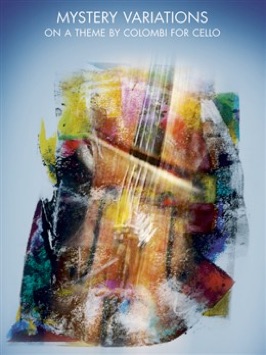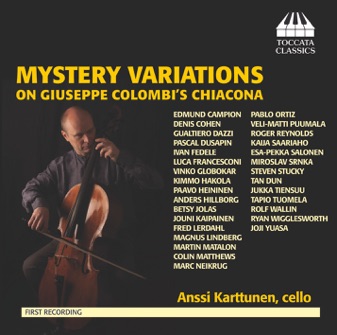Mystery Variations on the Chiacona of Giuseppe Colombi
2010
Contents:
Giuseppe Colombi: Chiacona
Jean-Baptiste Barrière: Anssi's eternal return (video) WATCH
Edmund Campion: Something to Go On
Denis Cohen: Chaconne
Gualtiero Dazzi: Variation sombre e libre d'apres Chiacona
Pascal Dusapin: 50 notes en 3 Variations
Ivan Fedele: Preludio e Ciaccona
Luca Francesconi: Anssimmetry
Vinko Globokar: Idée Fixe
Kimmo Hakola: Colombi Variation
Paavo Heininen: Triple Antienne
Anders Hillborg: Still and Flow
Betsy Jolas: A Fancy for Anssi
Fred Lerdahl: There and Back Again
Magnus Lindberg: Duello
Martin Matalon: polvo
Colin Matthews: Drammatico (with tape)
Marc Neikrug: Tiny Colombi
Pablo Ortiz: paloma
Veli-Matti Puumala: ... se sillan...
Roger Reynolds: Colombi Daydream
Kaija Saariaho: Dreaming Chaconne
Esa-Pekka Salonen: Sarabande per un Coyote
Miroslav Srnka: A Variation
Steven Stucky: Partite sopra un basso, per Anssi
Tan Dun: Chiacone - after Colombi
Tapio Tuomela: Idulla
Jukka Tiensuu: bLeuelein
Rolf Wallin: Ciacconetta
Ryan Wigglesworth: Arietta (after Colombi)
Joji Yuasa: Locus on Colombi's Chiacona

Variations by 31 composers on the Chiacona by Giuseppe Colombi (1635 -1694) for 'cello solo.
Written for the 50th birthday of Anssi Karttunen.

"Mystery Variations" was a gift for Anssi Karttunen's 50th birthday, masterminded by Kaija Saariaho and Muriel von Braun. They invited a number of his composer-friends to write short pieces for cello, using as a theme one of the first pieces written for the cello, the Chiacona by Giuseppe Colombi. The 31 pieces of Mystery Variations were collected by Chester Music into a unique leather-bound book and presented to Anssi. The whole set is being prepared for publication by Chester Music and will be available in November 2012.
Anssi Karttunen premiered the Finnish Variations in Helsinki on the 26th of September 2010 and 7 more in Paris on the 30th of September. More performances of the Variations followed in Strasbourg, Porto, Amsterdam, New York, San Francisco, Belgrad etc..
The first complete Mystery Variations performance took place in Paris in February 2011 at the Théâtre du Châtelet during the Festival Présences. In June 2011 Anssi performed the complete cycle together with the six cellists of Creative Dialogue IV in Santa Fe, USA.
A selection with choreography by Diana Theocharidis, entitled Cifra, was premiered in La Plata, Argentina in 2011 and again as Cifra 2 in Buenos Aires 2013.
The Mystery Variations offer a unique look at the numerous ways of writing for the cello today. It is a kaleidoscopic look into the history through the eyes of 30 composers, and a look into the future through the music of Colombi. They can be programmed in different combinations, in small or large groups or as a whole concert.
Helsinki, 26.9.2010: K Saariaho, K Hakola, P Heininen, AK, V-M Puumala, J-B Barrière,
J Tiensuu, T Tuomela, J Kaipainen.
Paris 30.9.2010: K Saariaho, P Ortiz, M Matalon, B Jolas, G Dazzi, AK, D Cohen.

MYSTERY VARIATIONS - The Amsterdam Concert 11.11.2010:
Giuseppe Colombi: Chiacona
02:47 Jouni Kaipainen: Anything Goes
05:15 Pascal Dusapin: 50 Notes en 3 Variations
07:12 Tan Dun: Chiacone - after Colombi
09:02 Kaija Saariaho: Dreaming Chaconne
11:58 Jukka Tiensuu: bLeuelein
15:06 Fred Lerdahl: There and Back Again
18:45 Pablo Ortiz: paloma
21:02 Luca Francesconi: Anssimmetry
23:32 Martin Matalon: Para Anssi
24:35 Magnus Lindberg: Duello
28:00- Interview
You can order you copy of the score from Musicroom.com by clicking on this picture.
The CD of Mystery Variations now available from Toccata Classics
New York Times MUSIC REVIEW
Two by a Finnish Composer, and Variations Inspired by a Birthday
By STEVE SMITH
Published: May 11, 2011
… Mr. Karttunen’s brilliant technique and gorgeous tone came into sharp focus in selections from Mystery Variations (2010), a compendium assembled for Mr. Karttunen’s 50th birthday, in which 31 international composers wrote brief variations on the “Chiacona” of the Italian Baroque composer Giuseppe Colombi.
After the stately Colombi, claimed to be the earliest work for unaccompanied cello (actually, bass viola da gamba), Mr. Karttunen performed variations by Kaija Saariaho, Marc Neikrug, Steven Stucky, Mr. Lindberg and Tan Dun. The range of responses to the source material was illuminating: Ms. Saariaho summoned ghostly whispers; Mr. Lindberg, crackling energy; Mr. Tan, antic strumming and ritualistic vocal shouts. Common to each was the composer’s obvious esteem for Mr. Karttunen’s abilities. …

seenandheard.com
New York’s Movado Hour concludes with Magnus Lindberg
… In between, Karttunen played five of the series of short pieces commissioned for his 50th birthday by his wife, the painter Muriel von Braun, and composer Kaija Saariaho. Inspired by Giuseppe Colombi’s Ciacona – the first extant piece for solo cello (from the mid-17th century) – thirty-one composers created brief homages, most lasting barely two minutes. Karttunen began with the skittering Colombi itself, followed by tributes from Saariaho, Steven Stucky, Marc Neikrug, Tan Dun and Lindberg. As a group they made liberal use of glissandi, trills, double stops, arpeggios – even some vocalizing (“Chaconne”) while slapping the instrument. Karttunen’s focus and precision were astonishing – so much so, that the entire set would have been welcome, time permitting. …
Bruce Hodges

Magnus Lindberg @ Baryshnikov Arts Center
…Karttunen was next, performing selections from The Mystery Variations: a set of variations on the first-ever work for solo cello, Giuseppe Colombi's Chiacona, written in 1670. Karttunen commissioned the variations from various composers last year, some of which closely resembled the original while others were, as Karttunen put it, "quite distant." Kaija Saariaho's Dreaming Chaconne, for example, sounded like it came from another universe while Steven Stucky's Partite sopra un basso, per Anssi was far more conventional. Lindberg's contribution, Duello, sounded at times like the Gigue from Bach's 5th cello suite, while Tan Dun's Chiacona had Karttunen shouting "Chaconne! Chaconne! Chaconne!" throughout. …

The Community Music Center previews Lindberg, Koh, and Karttunen
By Stephen Smoliar, SF Classical Music Examiner
…Karttunen could then introduce the audience to some samples from the Mystery Variations on the Chiacona of Giuseppe Colombi, his solo work on Sunday’s program. The source for the variations is Colombi’s 1670 “Chiacona a Basso Solo,” whose title refers to the pitch range of the instrument, rather than any specific instrument (such as a bass viol). As a result it is now recognized as the first composition ever written for solo cello. Karttunen was presented with a collection of 31 variations on this chiacona as a gift for his 50th birthday. After performing the chiacona yesterday evening, Karttunen give the United States premieres of three of the variations, “Birthday Greeting” by Edmund Campion (currently on the Berkeley Music Faculty), “Para Anssi” by Martin Matalon, and “Paloma” by Pablo Ortiz. Each variation took rather adventurous departures from the source; but Karttunen’s execution tended to “solve the mystery” by establishing the connections back to the original ….

An unexpected world premiere from San Francisco Performances
By Stephen Smoliar, SF Classical Music Examiner
…If I wrote about wanting to hear this music a second time on Saturday morning, I am now more that ready for my third encounter!
The same can be said of the samples from the Mystery Variations on the Chiacona of Giuseppe Colombi, a set of 31 variations that Karttunen sampled on Friday evening. At the preview performance he performed Colombi’s 1670 “Chiacona a Basso Solo,” followed by the United States premieres of three of the variations, “Birthday Greeting” by Edmund Campion (currently on the Berkeley Music Faculty), “Para Anssi” by Martin Matalon, and “Paloma” by Pablo Ortiz. This afternoon he added two more, the United States premiere of Roger Reynolds’ “Colombi Daydream” and the West Coast premiere of Lindberg’s “Duello.” When he introduced this music this afternoon, Karttunen began by saying that he would explain the use of “Mystery” in the title but seemed to lose sight of that goal while explaining that the variations were a present for his 50th birthday. Having now heard Colombi’s source twice as well as three of the variations, however, I have a conjecture.
What is probably most interesting about the variations Karttunen performed (and probably the remainder of the collection) is how diverse they are. In the midst of all that diversity, much of which may have provided each composer to draw upon his favorite devices for logic, grammar, and rhetoric, there was a clear tendency for the theme to be overshadowed by the variations, particularly variations that lasted for less than a quarter of the duration of the chiacona. However, as one becomes more familiar with the theme, one realizes that the entire collection can be treated rather like a musical version of Where’s Waldo? Some of the variations dwell on one of two surface features, leaving it to the listener to register those features in a new (and often rather densely populated) context. Others build on deeper aspects of Colombi’s structural architecture. The point is that Waldo is always there, so to speak; and different composers drop different hints when it comes to trying to find him. …
LA NACION, Argentina
Cifra
Fuertes imágenes de Theocharidis para el chelo de Karttunen
Por Néstor Tirri
Coreografía: Diana Theocharidis / Música: piezas breves de 21 compositores de distintas nacionalidades, interpretadas en chelo por Anssi Karttunen / Escenografía:Emilio Basaldua / Iluminación Gonzalo Cordova / Vestuario: Julián Garces / Elenco:Compañia Espacio Contemporáneo / Teatro: Tacec. Nuestra opinión: bueno
Lo que se impone es la niebla. Es un efecto escénico del que se ha abusado, pero que en este caso crea una atmósfera oportuna en un espacio vacío y ambiguo, inexplorado. El chelo, en escena, ataca con una improvisación y luego admite el refuerzo de otro chelo en playback (del inglés Colin Matthews, primero de los numerosos compositores que se sucederán en la obra, entre los que están los argentinos Martín Matalón y Pablo Ortiz).
Las ocho presencias que van ocupando el espacio escénico, sumidas en el humo y recortadas en el contraluz de un desolado fondo blanco, adquieren una forma espectral. Con insistencia, la coreografía de Diana Theocharidis, en el despojado ámbito experimental del Teatro Argentino, depara un módulo repetitivo de cuerpos que se desmoronan y luego se yerguen, en un juego de caída-recuperación. También se reiteran los dúos, en confrontaciones que entrelazan y distancian.
El excepcional chelista finlandés Anssi Karttunen, en escena bajo una luz cenital, entabla el hilo conductor de Cifra , una performance coreográfico-concertante que pivota alrededor de la condición críptica ("indes-cifrable") del discurso artístico. El ascetismo de los compositores de música contemporánea que proporcionan la base sonora (a los que hay que sumar la partitura original de Colombi) encuentra su mejor correspondencia escénica en los momentos de calma de las figuras físicas; en esa tesitura ascética, no obstante, algunas de las composiciones trasuntan, en la interpretación de Karttunen, una intensidad lacerante.
La base musical -veinte de las treinta y una variaciones que otros tantos compositores dedicaron a Karttunen como tributo en su 50º cumpleaños- es una exhaustiva exploración en torno al espíritu posrenacentista de la Ciaccona del italiano Giuseppe Colombi, una de las primeras obras que fueron compuestas para ese instrumento; propuesta inteligente, sin duda, de un refinamiento estético que, por eso mismo, a veces ejerce demasiada gravitación como para sostener simultaneidad con la otra propuesta, la coreográfica. Dicho de otro modo, dos entidades vigorosas en disciplinas distintas (sobre todo considerando la absorbente ejecución de Karttunen) no siempre se integran en el resultado escénico.
No obstante, en la aridez del espacio desierto, los ocho cuerpos organizados en parejas se montan unos sobre otros y reptan, mientras el chelo gruñe en sus registros más profundos, como buceando en zonas ancestrales de la creación. Es uno de los tramos mejor plasmados de esta nueva concepción de Theocharidis, acaso más ambiciosa en cuanto a horizonte musical (una orientación ya evidenciada en sus tempranas experiencias en torno a las partituras de Scelsi) que en los posibles alcances de su exploración coreográfica, a la que los jóvenes integrantes de la Compañía Espacio Contemporáneo respondieron con reconcentrada entrega.
"Cifra" a choreography by Diana Theocharidis,
Music: 21 Mystery Variations.
October 2011, La Plata, Argentina

